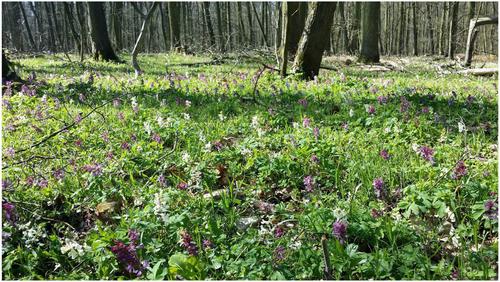Our official English website, www.x-mol.net, welcomes your feedback! (Note: you will need to create a separate account there.)
Contrasting responses of forest phenological guilds to complex floodplain change
Journal of Ecology ( IF 5.5 ) Pub Date : 2024-04-22 , DOI: 10.1111/1365-2745.14310 Anežka Holeštová 1 , Jana Doudová 1 , Alena Havrdová 1 , Marie Černá 1 , Karel Boublík 1 , Jan Douda 1
Understanding the seasonal dynamics of the forest herb layer and the factors that influence it is essential for predicting how the forest ecosystem, including mutualistic interactions, will respond to global change. However, to date, no research has investigated how understorey phenological guilds respond to major environmental threats and forest interventions. We showed the marked changes in the phenological structure of floodplain forest plant communities over half a century at a multi‐regional scale in Central Europe. Unlike previous studies focusing on individual species' responses to climate change, we examined shifts in species richness, frequency and abundance between phenological guilds within the plant community. We examined the effects of temporal variation in climate, hydrology, soil conditions and canopy structure, and assessed the effects of non‐intervention and intervention management on phenological guild responses. Our results show a significant loss of local species richness and a decline in species frequency in the forest understorey vegetation, associated with species exhibiting summer phenology. In contrast, an increase in abundance and richness of spring flowering species was observed, attributed to high nutrient loads and reduced flooding, respectively. The abundance of spring species increased only in stands where canopy cover increased over time, probably due to the suppression of summer flowering species, allowing spring flowering species to spread on open, bare ground. The community experienced a shift in maximum flowering plant richness from June to May. Despite management interventions such as clearcutting and tree planting, our data show similar temporal trajectories in intervention and non‐intervention forests, indicating that changes in phenological structure are largely independent of recent management activities. Synthesis . We propose that a complex interplay of environmental factors, rather than climate change alone, is shaping shifts towards earlier phenological guilds in floodplain forests. This study highlights the importance of considering a comprehensive view of phenological guild dynamics and the impact of environmental factors on forest plant community structure in the face of global change.
中文翻译:

森林物候协会对复杂洪泛区变化的对比响应
了解森林草本层的季节动态及其影响因素对于预测森林生态系统(包括互利相互作用)如何应对全球变化至关重要。然而,迄今为止,还没有研究调查林下物候群如何应对主要环境威胁和森林干预措施。 我们展示了半个世纪以来中欧多区域尺度洪泛区森林植物群落物候结构的显着变化。与之前关注单个物种对气候变化的反应的研究不同,我们研究了植物群落内物候群之间物种丰富度、频率和丰度的变化。我们研究了气候、水文、土壤条件和冠层结构的时间变化的影响,并评估了不干预和干预管理对物候反应的影响。 我们的结果显示,森林林下植被中当地物种丰富度显着丧失,物种频率下降,这与表现出夏季物候的物种有关。相比之下,春季开花物种的丰度和丰富度有所增加,这分别归因于高养分负荷和洪水减少。春季物种的丰度仅在树冠覆盖度随着时间的推移而增加的林分中增加,这可能是由于夏季开花物种的抑制,使得春季开花物种能够在开阔的裸露地面上传播。从六月到五月,该社区经历了开花植物最丰富度的转变。尽管采取了砍伐和植树等管理干预措施,但我们的数据显示干预森林和非干预森林的时间轨迹相似,表明物候结构的变化在很大程度上独立于近期的管理活动。 合成 。我们认为,环境因素的复杂相互作用,而不仅仅是气候变化,正在塑造洪泛区森林向早期物候行会的转变。这项研究强调了面对全球变化时综合考虑物候群动态和环境因素对森林植物群落结构影响的重要性。
更新日期:2024-04-22
Journal of Ecology ( IF 5.5 ) Pub Date : 2024-04-22 , DOI: 10.1111/1365-2745.14310 Anežka Holeštová 1 , Jana Doudová 1 , Alena Havrdová 1 , Marie Černá 1 , Karel Boublík 1 , Jan Douda 1
Affiliation

|
中文翻译:

森林物候协会对复杂洪泛区变化的对比响应



























 京公网安备 11010802027423号
京公网安备 11010802027423号